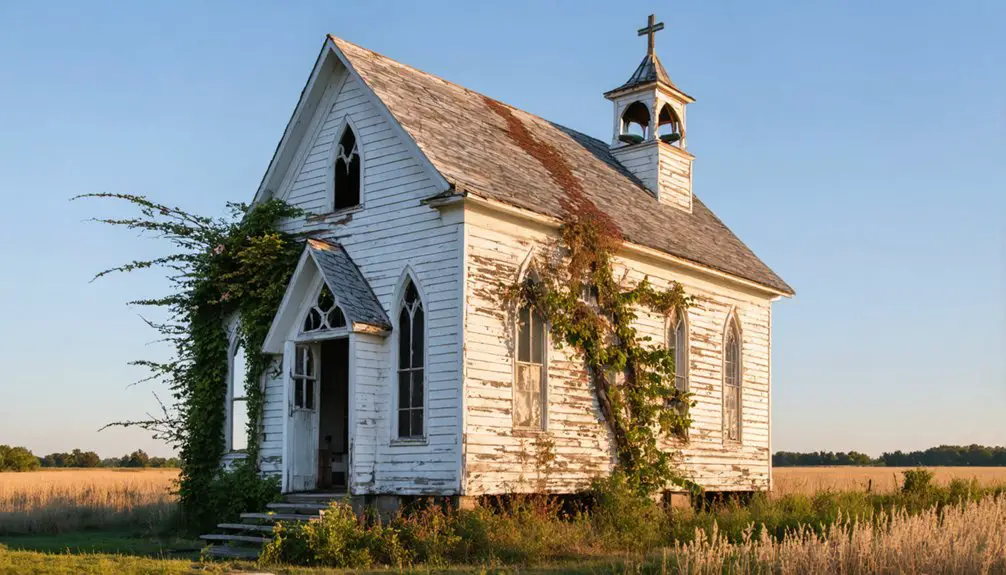You’ll find Princeton’s ghostly remains along Mississippi’s riverbank, where three communities merged in the 1840s to create a bustling river port. Named after William Berry Prince, the town thrived on cotton trade and steamboat commerce until natural disasters struck. River course changes, floods, and economic shifts led to its abandonment, and today nature has completely reclaimed the site. Princeton’s transformation from prosperity to wilderness holds fascinating lessons about the Mississippi River’s power to shape human settlements.
Key Takeaways
- Princeton was established in the 1840s by merging three communities and grew into a prosperous Mississippi River port town.
- The town’s economy thrived on cotton production, river commerce, and transportation until the late 19th century.
- Natural disasters, including floods and river course changes, destroyed the port and made agriculture impossible.
- Population declined as transportation routes shifted, leading to complete abandonment and ghost town status.
- Today, the site is completely reclaimed by forest and incorporated into the Mississippi Levee system, with no remaining structures.
Origins and Early Settlement
While many Mississippi River settlements emerged organically, Princeton’s formation stemmed from the deliberate merging of three distinct communities – Pinneo’s Landing, Elizabeth City, and Pinnacle Point – in the 1840s.
Named after William Berry Prince, an early settler near Lake Jackson, the town’s settlement patterns reflected the pioneering spirit of its founders. Like the historic town of Rodney, Princeton experienced significant growth as a bustling river port.
William Berry Prince’s legacy lives on in this river town, where early pioneers carved civilization from untamed wilderness.
The Pinneo brothers arrived in 1836, establishing essential early infrastructure through their ferry services and homesteads. They were joined by Thomas Hubbard and Israel Atherton, who also operated ferries to Illinois.
By 1860, Princeton had grown to nearly 1,000 residents, with cabins and structures distributed between the south and northwest sections. The town’s primary economic focus was wheat farming until severe droughts in the late 1890s forced agricultural diversification.
You’ll find that the town’s strategic position on the Mississippi River shaped its development, though muddy roads through the Wapsipinicon River area often challenged travel.
Life Along the Mississippi River
As steamboats churned along the Mississippi River in the mid-1800s, Princeton emerged as an essential hub for river commerce and transportation.
You’d find the town’s economy deeply intertwined with the river culture, as lumber mills, quarries, and agricultural facilities sprung up along its banks. The Mississippi’s 9-foot deep channel allowed larger vessels to transport bulk materials like coal, iron, and timber, connecting Princeton’s industries to distant markets. Thanks to wing and closing dams built throughout the nineteenth century, the river could better maintain its shipping channels. Native American settlements had long recognized the river’s importance for trading and sustenance before European arrival.
You could witness how the river fostered community connections, as steamboats brought not just goods but also cultural exchanges between settlements.
The town’s proximity to the Mississippi’s engineered waterways, maintained by continuous dredging and dam systems, guaranteed Princeton’s crucial role in the region’s commercial network until railroad competition emerged.
The Cotton Economy’s Impact
Once cotton cultivation transformed Princeton’s agricultural landscape in the early 1800s, you’d find the town’s economy increasingly dependent on this lucrative crop.
The introduction of Petit Gulf cotton, a revolutionary hybrid strain, dramatically boosted local cotton production. You’d witness this economic transformation accelerate after the Indian Removal Act of 1830, when fertile Delta lands became available for as little as 40 cents per acre.
The expansion of cotton plantations relied heavily on enslaved labor, with forced migrations bringing workers from upper southern states. By 1830, slave populations exceeded white residents throughout Mississippi. Merchants established sophisticated global trading networks to distribute Princeton’s cotton to international markets. By the mid-19th century, you’d see Mississippi emerge as the nation’s leading cotton producer, with Princeton benefiting from this agricultural dominance.
However, this prosperity came at a devastating human cost through the exploitation of enslaved people and displacement of Native Americans.
Natural Disasters and Environmental Changes
Through relentless natural forces, Princeton’s fate was sealed by the ever-shifting Mississippi River and its devastating floods. The town’s struggle against environmental changes proved futile as natural disasters reshaped the landscape, ultimately claiming this once-thriving port settlement.
Much like Princeton University founded in 1746, this Mississippi town’s rich history was deeply connected to the landscape that shaped it.
You’ll find that Princeton’s downfall stemmed from these unstoppable forces:
- The Mississippi River’s dramatic course changes moved several miles away, abandoning the port that was Princeton’s lifeline.
- Devastating floods saturated the land, making it impossible to maintain buildings or farm the soil.
- Gradual land subsidence caused the town to sink, while wetland loss removed natural buffers.
- Storm surges and hurricanes delivered the final blows, accelerating the destruction of remaining infrastructure.
Today, you’ll see only forest and levee where Princeton once stood, a reflection of nature’s raw power. Like the historic town of Burrwood, Princeton succumbed to the destructive combination of erosion, subsidence, and wetland destruction that plagues many Mississippi Delta settlements.
Population Decline and Abandonment
Despite Princeton’s early prominence as a bustling river port, the town experienced a devastating population decline beginning in the late 19th century.
Like the ghost town of Rodney, Mississippi, Princeton faced similar challenges when changing river patterns disrupted vital transportation routes.
You’ll find that the exodus began as river commerce waned and transportation networks shifted elsewhere, leaving the once-vibrant community struggling to maintain its economic significance.
The collapse of cotton trading and local industries dealt severe blows to community resilience, prompting younger generations to seek opportunities in larger cities.
Empty abandoned buildings now stand as silent reminders of the town’s former life and prosperity.
As the population dwindled, crucial services like schools, banks, and churches shuttered their doors, making rural revitalization increasingly challenging.
The town’s aging demographic, combined with outmigration and reduced birth rates, created a downward spiral that ultimately transformed Princeton from a thriving settlement into an abandoned ghost town.
Transportation Revolution’s Effect
The transportation revolution dealt a decisive blow to Princeton’s viability when new railroad networks transformed the region’s economic landscape.
The transportation evolution reshaped commerce through four key developments:
The evolution of transportation networks fundamentally altered regional commerce, creating winners and losers through key infrastructure shifts.
- The Fordyce and Princeton Railroad’s initial timber operations boosted the town’s prospects, but when timber resources depleted, abandoned rail lines severed essential economic lifelines.
- Highway systems like U.S. 82 bypassed Princeton entirely, redirecting trade flows to other communities.
- The economic transformation left Princeton isolated from emerging commercial corridors.
- The shift from rail to road transportation eliminated Princeton’s strategic importance.
You’ll find that this pattern of declining transportation access mirrors many ghost towns throughout the Mississippi Delta, where changing infrastructure priorities determined which communities would thrive and which would fade into obscurity.
What Remains Today
Modern visitors seeking remnants of Princeton’s once-bustling port will find nature has reclaimed virtually every trace of human habitation. The site is now completely covered by forest and partially incorporated into the Mississippi Levee system, with no standing structures or visible infrastructure remaining.
Unlike other ghost towns in the region, you won’t find any underwater ruins, exposed foundations, or historical markers at Princeton’s location.
The absence of physical remains has limited archaeological interest in the area, with no documented artifacts or relics recovered from the site.
You’ll find no public access points, trails, or interpretive signage marking this lost settlement. The town’s legacy survives only through historical records, while its physical presence has vanished beneath the natural landscape and flood control infrastructure.
Legacy and Historical Lessons
While Princeton’s physical structures have vanished beneath forest and flood control infrastructure, its historical legacy offers valuable insights into the economic and social vulnerabilities of Mississippi River settlements.
The town’s disappearance serves as a powerful reminder of economic fragility and the risks of depending on a single industry. As you study Princeton’s history, you’ll find compelling lessons about survival and adaptation in the American South.
Key lessons from Princeton’s story:
- River towns can quickly fade when environmental conditions or trade routes shift
- Economies built on single industries face heightened vulnerability to market changes
- Cultural memory requires active preservation, even when physical structures disappear
- Communities dependent on natural resource extraction often face uncertain futures
Frequently Asked Questions
Were There Any Notable Civil War Battles or Events in Princeton?
Like a whisper lost to time, you won’t find any major Civil War battles in Princeton. While the town existed during this period, it didn’t hold local significance in recorded wartime events.
What Types of Buildings and Businesses Existed During Princeton’s Peak Period?
You’d find historical architecture ranging from residential cabins to churches, alongside commercial enterprises including banks, saloons, hotels, general stores, and mining-related facilities serving the bustling community.
How Did Native American Communities Interact With Princeton’s Early Settlers?
You’ll find early interactions centered on cultural exchange and trade relationships, though these quickly gave way to displacement as settlers expanded cotton cultivation and Native Americans lost their lands through treaties.
Did Any Famous Historical Figures Have Connections to Princeton?
Like footprints fading in time, you’ll find few famous residents made their mark here. Beyond U.S. Representative William H. Hammett, historical connections remain sparse in documented records.
What Archaeological Discoveries Have Been Made at the Princeton Site?
You’ll find brick walls, porcelain doorknobs, and metal artifacts revealed during low river levels. These archaeological artifacts offer glimpses of 19th-century life, though historical preservation remains challenging due to water coverage.
References
- https://mississippifolklife.org/articles/haunted-by-a-ghost-town-the-lure-of-rodney-mississippi
- https://en.wikipedia.org/wiki/Greenville
- https://www.youtube.com/watch?v=pinIgUFWDT0
- https://dbpedia.org/page/Princeton
- https://www.tiktok.com/@grace_goodnight/video/7530056656164490527?lang=en
- https://mississippivalleytraveler.com/princeton/
- https://slavery.princeton.edu/stories/princeton-and-slavery-holding-the-center
- https://en.wikipedia.org/wiki/Princeton
- http://mainland.cctt.org/istf2006/history.asp
- https://rosap.ntl.bts.gov/view/dot/67823/dot_67823_DS1.pdf



